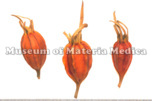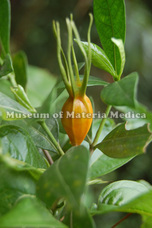Gardenia Fruit

|
Market name:山梔子 Photo location:Museum of Materia Medica, Inst. of Nat. Med. TMPW No.:19903 |

|
Plant name:Gardenia sp. Photo location:China Photographer:K. Komatsu |
| Synonym | Cape Jasmine Fruit |
| Latin name | Gardeniae Fructus |
| Botanical source: Family name | Rubiaceae |
| Botanical source: Plant name | Gardenia jasminoides J.Ellis (IPNI:751073-1) |
| Part used | Dried ripe fruit |
| Empirical criteria for quality selection | G. jasminoides: circular fruit, G. jasminoides var. glandiflora ovoid fruit. Fruit circular, fully grown, sanguine in color is considered superior in quality (TN). |
| Constituents | Monoterpenoids: Iridoids: Gardenoside, Geniposide, Genipin, Genipin 1-beta-gentiobioside, Shanzhiside, Methyl decacetylasperuloside, Geniposidic acid, 10-Acetylgeniposide, Gardoside, Scandoside methyl ester; Geniposide, Gardenoside, and the following are metabolites: Genipinine, Genipinine monoacetate, Gardenogenin A, Gardenogenin B, Gardenine Carotenoids: Crocin (Crocetin + Gentiobiose) Other aromatic derivatives: p-オキシケイヒ酸誘導体 |
| Pharmacological effects | Aperient, stimulation of bile secretion, suppression of gastric juice secretion, analgesic (geniposide). Stimulation of bile secretion, suppression of increase in bilirubin and cholesterol in blood (crocin, crocetin, extract). Hypotensive (extract). |
| Indications | As an antiinflammatory drug, hemostatic, sedative, for normalizing the function of gallbladder, it is applied to treat fidgetiness (mental instability) due to congestion or inflammation, hematemesis, hematuria, congestion and jaundice. For external use, the powder should be blended with the powder of huangbo and other materials, then kneaded with vinegar. It is applied to bruise externally. |
| Diseases | Malaise due to feeling hot in the chest, High fever, Disturbance of consciousness, Red eye, Feeling of bitter in the mouth, Thirst, Jaundice, Urodynia, Dysuria, Cloudy urine, Hematemesis, Nasal hemorrhage, Hematochezia, Hematuria, Internal bleeding, Pyogenic dermatosis, Swelling and pain due to contusion, Burn |
| Formulas | inchinkoto , unseiin , orengedokuto , kagenryokakusan (asada) , kagenryokakusan (kyoteiken) , kakkonkokato , kamikihito , kamigedokuto , kamishoyosan , kamishoyosankasenkyujio , karokijitsuto , keigairengyoto , gorinsan , saikoseikanto , shishikankyoto , shishishito , shishihakuhito , shin'iseihaito , jijinmeimokuto , seijobofuto , seihaito , senkanmeimokuto , bofutsushosan , rikakuto , ryutanshakanto , ryokakusan |
| Meridian tropism | Heart, Liver, Lung, Kidney |
| Property | Cold |
| Flavor | Bitter |
| Classification in "Shen-non Ben-cao Jing" | Middle |
| TCM: Classification | Antipyretics |
| TCM: Medicinal effects | To reduce fire and ease the mind, to eliminate damp heat, to remove heat from blood and counteract toxicity. Used for febrile disease with restlessness, jaundice with dark urine, hematuria with difficult painful urination, hemoptysis and epistaxis caused by heat in the blood, inflammation of the eye, boils and sores, external use for sprains and bruises. |
| Remarks | Listed in the Japanese Pharmacopoeia 18th ed. |
| References | TN: T. Namba & Y. Tsuda ed., Outline of Pharmacognosy, a Textbook, 3rd ed., Nankodo Co., Ltd., Tokyo, 1998. |
DNA sequences of medicinal plants
| Gene Region | |||||||||||||||||||
| Nuclear | Chloroplast | Mitochondria | |||||||||||||||||
| Botanical source: Plant name | 5Ss | 18S | ITS1 | 5.8S | ITS2 | 26S | others | trnH-psbA | matK | trnK | trnK-rps16 | trnT-L | trnL | trnL-F | rbcL | rpoC1 | ndhF | others | |
|
|
|||||||||||||||||||
